Dynamic Analysis and Optimal Control of Rumor Propagation Model with Reporting Effect
Abstract
Media reports and the number of rumors in the media have an important impact on the spread of rumors. Currently, studies that consider these two factors comprehensively on rumor propagation are uncommon. It is better to consider both effects comprehensively than to consider one of them alone. In this paper, we established a new propagation model, which regards the number of rumors in the media as a subclass that changes with time, and then comprehensively considered the effect of these two factors on the process of rumor propagation. We proved the existence and stability of equilibrium points of the model. Then, we selected two reasonable control variables: science popularization intensity and punishment intensity. We find that the control effects are optimal when these two control variables take the maximum value. Theoretical analysis and numerical simulation results showed that positive media publicity can reduce the spread of rumors, but cannot stop the spread of rumors. And under the parameters given in this paper, the optimal control parameter values satisfying the constraints can be calculated through quantitative analysis. This method provided a new idea for studying the optimal control of rumor propagation.
1. Introduction
A rumor is an untrue or unconfirmed social speech that can spread quickly on a large scale [1]. Rumors spread will cause people to panic, which may produce or exacerbate social unrest and adversely impact people’s production, lives, social development and stability. For example, the novel coronavirus pneumonia pandemic started in early 2020, and false information disseminated in the treatment process caused a degree of social panic [2]. In April 2021, Japan proposed a plan to address the issue of nuclear sewage in the sea; some criminals worldwide exploited the plan to spread false information, provoke international relations and disrupt social order [3]. The spread of these rumors has created unprecedented challenges to the stable development of the country and society. Hence, an investigation of the propagation characteristics of rumors and control strategies to reduce the diffusion of rumors is critical.
Previous studies have revealed that the characteristics of rumors in the transmission process are similar to those of infectious diseases in the population [4, 5]. In 1965, the DK model was proposed in document [6, 7], which is the earliest recorded theory of rumor propagation. In 1973, Maki and Thompson [8] conducted research on the foundation of the DK model and proposed the MT model. Henceforth, related researchers have performed much research on the seat of the DK model and MT model [9, 10]. Inspired by this finding, research on the dynamic analysis and mathematical modeling of the rumor propagation process has developed rapidly, and many scholars have achieved considerable research progress [11, 12]. In terms of expanding the research on rumor spreading systems, certain scholars have considered the nonlinear spreading rate [13–15], environmental fluctuations [16–18], individual emotional factors [19, 20], time delay [21, 22], rumor control [23, 24] and other influencing factors, which adds new content to the existing rumor propagation theory.
By studying the above influencing factors, many scholars have further considered the influence of the forgetting mechanism [25–27] and other communication mechanisms [28, 29], proportion of wise people [30], and vigilance [31] of rumor spread on the process of rumor spread. Gu et al. [25] considered the influence of forgetting and memory mechanisms on the spread process of rumors and proposed that under certain conditions, forgetting and memory mechanisms would terminate the propagation process of rumors. In 2011, Zhao et al. [26], combined with the forgetting mechanism, established the rumor propagation model on the online social blog platform Livejournal. On this basis, Zhao et al. [27] discussed the influence of the new state of the hibernator on the rumor propagation process and proposed a rumor propagation model. Considering the different personal attitudes toward the propagation of rumors, Hu et al. [28] proposed the hypothesis that the public has three attitudes toward rumor propagation: They like the propagation of rumors, they do not like the propagation of rumors, and they are hesitant (or neutral) about the propagation of rumors. Xia et al. [29] mainly considered the attractiveness and fuzziness of rumor content and proposed a new model. Hu et al. [30] proposed a model that considers the influence of the proportion of wise people in the network on the rumor propagation process. Qiu and Liu [31] added a new state of vigilance to describe the above phenomenon and proposed a SVIR (susceptibility-vigilance-infection-recovery) model.
Considering the great harm in the spread of rumor information, how to control it has become a hot topic among scholars [32–38]. In the current research, scholars have considered the factors that affect the spread of rumors, such as control cost [32], feedback mechanism [33], multichannel network interaction [34], competitive information dissemination [35], and established an innovative model. Cheng et al. [36] established an improved rumor propagation model that takes into account the interactive time-delay system, considered the strategy of controlling rumor propagation, and proposed an optimized control method. Yu et al. [37] discussed the propagating characteristics of rumors on online social networks and formulated relevant tactics. Zhu and Wang [38] considered the influence of forced silence on communicators, proposed a new rumor dissemination model, and discussed the optimal control method to reduce the frequency of rumor propagation.
In addition, different scholars adopt different calculation methods when solving the differential equation and proving the stability of the equilibrium point. In the existing research, Routh-Hurwitz stability criterion [39] is usually used to judge the stability of the equilibrium point. Qayyum et al. [40] first extended the theoretical study of thin film flow of non-Newtonian Johnson-Segalman fluid in fractional space. The homotopy perturbation method and the Caputo definition of fractional derivative are used to solve the fractional boundary value problem. That avoids the error caused by choosing different numerical parameters. The validity and convergence of the numerical solution are verified by calculating the residuals in different cases. And the results show that the fractional parameters have opposite effects on the fluid velocity.
For the first time, Qayyum et al. [41] have been performed the homotopy-based fractional analysis of thin film flow of pseudo-plastic fluid on a vertical. They comprehensively considered three cases to solve the problem of different parameter values. In addition, the influence of parameters on velocity profile is also studied graphically. The results show that overestimating the generated magnetic field will lead to the delay of the velocity field. And the velocity distribution decreases slightly with the increase of parameter α.
In the existing research, some scholars have considered the influence of the media reporting effect on the process of rumor propagation, or regarded the media as a separate subclass. However, it is not common to consider the impact of the two on the communication process. In this paper, we comprehensively considered the influence of the two on the rumor spreading process and established a new rumor propagation model. Distinct from previous studies, we hold that the number of rumors in mass media is a variable that changes over time and discuss the individual-to-individual and media-to-individual transmission mechanisms. The effect of media coverage has an important impact on the propagation of rumors. Thus, exploring the impact of the media reporting effect on the spread of rumors is important. The media report effect factor is introduced in this paper, and the influence of positive media reports and negative reports on the spread of rumors are discussed separately. Taking into account the possible consequences and effects of rumors, dominating the propagation of rumors is the ultimate target of our research.
This paper is structured as follows: In Section 2, we propose a rumor propagation model considering media effect. In Section 3, we testify that the local asymptotic stability of frontier equilibrium and internal equilibrium undergo mathematical analysis. In Section 4, using Pontryagin’s greatest principle, by analyzing the related issues of the optimum control of the rumor propagation model, certain policies are proposed to decrease the propagation of rumors. In Section 5, the feasibility of the results is demonstrated through numerical simulations. The sensitivity of each parameter in the model is analyzed. We present our conclusions and propose effective measures to maintain social stability and economic development.
2. Rumor Propagation Model with Reporting Effect
In the light of the classical rumor propagation model, we use N(t) to express the changeable population size of t at any moment. Using the method of warehouse model, the crowd is divided into three categories: rumor susceptible (people who has never heard a rumor), rumor disseminator (such people spread rumors), and rumor immune (such people will not spread rumors), denoted by S(t), I(t) and R(t). The number of rumors in the media is represented by W(t).
This paper assumes that individuals enter the rumor communication system at a constant rate Λ. At the same time, considering that the ignorant, rumor spreader and immune exit the rumor communication system for some specific reasons, this paper assumes that the ignorant, rumor spreader and immune all have the same mobility μ. Regarding the sub-category of media, λ represents the probability of the rumor spreader spreading rumors to the media per unit time. Taking into account the coverage of subsequent information in the media and other reasons, this paper assumes that the rumor information in the media has a certain ratio k be submerged.
When a rumor disseminator meets a rumor susceptible person and hears the rumor information, if the ignorant believes and spontaneously spreads the rumor, it will spread the rumor with a certain probability β. If an ignorant person has correct judgment on rumors and realizes that the rumors are untrue or is not interested in rumors, they will become immune with probability η. If the rumor spreader realizes that the rumored information is false or forgets the rumored information because of seeing new information, he becomes a rumor immune person with probability α.
The media report effect plays a crucial role in the scale of rumor spreading and the content of rumor spreading. When ignorant people are exposed to rumor information in media, consider the impact of media reporting effect m: When m > 0, it means the influence of positive media publicity on rumor propagation. When m < 0, it means the influence of negative media publicity on rumor propagation. Since rumors do not stop spreading due to media reports, we can obtain m < β.
In the above analysis, all the parameters are positive numbers, which results in a schematic diagram of the media dissemination of rumors considering the effect of media reports, as shown in the following figure.
As shown in Table 1, the specific meanings of different parameters contained in Figure 1 are as follows.
| Parameter | Description |
|---|---|
| S(t) | The density of susceptible individuals at time t |
| I(t) | The density of infectious individuals at time t |
| R(t) | The density of rumor recovery individuals at time t |
| W(t) | The number of rumors in the media at time t |
| Λ | The entering number of susceptible individuals per unit of time |
| μ | The emigration rate of individuals per unit of time |
| β | The transmission rate from spreading individuals to susceptible individuals |
| m | The parameter affected by positive media reports and negative media reports |
| η | The recovery rate of susceptible individuals |
| α | The recovery rate of spreading individuals |
| λ | The discharge quantity of message into medium |
| k | The submerged rate of message |
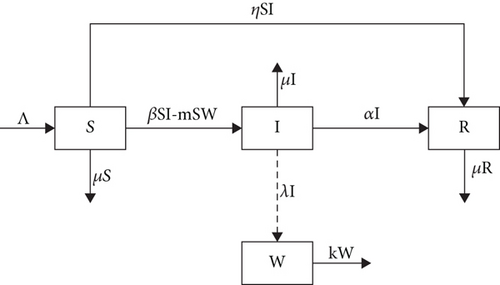
Figure 1 indicates that the state changes of the number of rumors in the ignorant, rumor spreader, immune, and communication medium per unit time are as follows.
In the unit time, individuals with a number of Λ enter the population, and these individuals are susceptible. The number of individuals who believe and spread rumors after contacting the communicators is βSI. The number of individuals who do not spread rumors after contacting the disseminator is ηSI. The number of individuals who become communicators under the influence of media coverage effect is mSW. The number of susceptible individuals who have moved out for some reason is μS. So, the number of susceptible individuals varies within a unit time: B − (βSI − mSW) − ηSI − μS.
In unit time, some susceptible individuals who contact and know rumors are partially transformed into communicators. The number of these individuals is βSI. The number of individuals who become communicators under the influence of media coverage effect is mSW. The number of affected individuals converting to the immune individuals is αI. The number of the disseminator who have moved out for some reason is μI. So, the number of spread individuals varies within a unit time: βSI − mSW − αI − μI.
In unit time, some susceptible individuals who contact and know rumors are partially transformed into the immune individuals. The number of these individuals is ηSI. The number of affected individuals converting to the immune individuals is αI. The number of immune individuals who have moved out for some reason is μR. So, the number of immune individuals varies within a unit time: ηSI + αI − μR.
In unit time, the number of rumors spread by the disseminator to the media is λI. Due to the coverage of information in the media, some rumors disappeared. The number of this part is kW. So, the number of rumors in the media varies within a unit time: λI − kW.
where Λ > 0, α > 0, β > 0, μ > 0, η > 0, k > 0, λ > 0, m < β.
3. Model Analysis
Lemma 1. The closed set Ω = {(S, I, R, W) ∈ R4, N ≤ Λ/μ, W > 0} is the positive invariant set of model (1).
Proof. It is easy to know that dN/dt = Λ − μN, so N(t) = (N0 − Λ/μ)e−μt + Λ/μ, where N(0) = N0, and then limt⟶∞N(t) = Λ/μ. The positive invariant set of system (1) is Ω = {(S, I, R, W) ∈ R4, N ≤ Λ/μ, W > 0}.
3.1. The Basic Reproduction Number R0
The basic reproduction number R0 [42] represents the expectation of introducing a disseminator into the susceptible population and the number of people that the disseminator can infect in the average cycle of rumor spread. When R0 < 1, the number of spreaders who can spread during their average spreading period is less than 1; then, the rumors will disappear by themselves. When R0 > 1, the number of communicators who can spread during their average transmission period is greater than 1, and the amount of rumor communicators gradually increases until they reach the summit. This paper uses the next-generation matrix method to calculate the basic reproduction number R0 of Equation (1).
3.2. Existence of Equilibrium
On the basis of the system kinetic Equation (1), we can figure out the equilibrium E = (S, I, R, W). Easily, we find out the positive equilibrium points of system (1) are E0 = (Λ/μ, 0, 0, 0) and E∗ = (S∗, I∗, R∗, W∗), and the rumor-free equilibrium point E0 invariably exists.
Theorem 1. The equilibrium point E∗ = (S∗, I∗, R∗, W∗) exists if R0 > 1.
Proof. The rumors about system (1) have an equilibrium point that satisfies:
So I∗ > 0 when R0 = (Λ(kβ − λm))/(kμ(α + μ)) > 1.
3.3. Stability of Equilibrium
Theorem 2. The equilibrium point E0 = (Λ/μ, 0, 0, 0) is locally asymptotically stable if R0 < 1, m > 0 and .
Proof. The Jacobian matrix of system (1) at E0 = ((Λ/μ), 0, 0, 0) is
Therefore, the characteristic root corresponding to the characteristic equation of J(E0) is h01 = h02 = −μ < 0.
Then, we can obtain h2 + (k + α + μ − β(Λ/μ))h + k(α + μ − β(Λ/μ)) + λm(Λ/μ) = 0.
where Δ1 = (α + μ − k − β(Λ/μ))2 − 4[(α + μ − β(Λ/μ)) + λm(Λ/μ)].
According to Routh-Hurwitz stability criterion [39], the equilibrium point E0 = ((Λ/μ), 0, 0, 0) is locally asymptotically stable if R0 < 1, m > 0 and .
Theorem 3. The equilibrium point E∗ = (S∗, I∗, R∗, W∗) is locally asymptotically stable if R0 > 1, m < 0, β > α + μ and kβ > λm(1 − α − μ).
Proof. The Jacobian matrix at E∗ = (S∗, I∗, R∗, W∗) is
It is easy to obtain h01 = −μ < 0.
where C1 = μR0 + (−λm)((α + μ)/(kβ − λm)), C2 = (−λm)((μR0(α + μ))/(kβ − λm)).
Bring the parameters into the above formula to get: b2b1 − b3b0 = C1(C2 + A3) − λmS∗(ηI∗ + μ) + [kβ − λm(1 − α − μ)]((Λ(C1 + k))/(μ(α + μ)R0)).
Hence, when R0 > 1 and m < 0, we can obtain A3 = ((Λ(kβ − λm))/(kμR0))(η + β)I∗ > 0, C1 = μR0 + (−λm)((α + μ)/(kβ − λm)) > 0, C2 = (−λm)((μR0(α + μ))/(kβ − λm)) > 0.
Hence, when R0 > 1, m < 0, β > α + μ and kβ > λm(1 − α − μ), we can obtain bi > 0(i = 0, 1, 2, 3), b2b1 > b3b0.
According to the Routh-Hurwitz stability criterion [39], the equilibrium point E∗ = (S∗, I∗, R∗, W∗) is locally asymptotically stable if R0 > 1, m < 0, β > α + μ and kβ > λm(1 − α − μ). Theorem 3 can be proved.
4. Optimal Control
In view of the new rumor dissemination model established abovementioned, in this section, the model is applied to the population in a closed social communication environment. In this paper, two control objectives are proposed. In a certain control time interval, the number of rumor propagators should be reduced, and the number of immune persons should be increased. On the other hand, by controlling the scale of rumor spreading, the cost of human, material, and financial resources will be minimized. Then, the corresponding optimal control problem is studied. Consider that conversion rates β(t) and α(t) have the maximum influence of the rumor propagation model constructed in this paper. Consequently, two proportional constants β and α in the model are transformed into the control variables β(t) and α(t). In this section, for the convenience of calculation, we make β = 1 − μ1, α = μ2. Specifically, the control variable μ1(t) is used to control the proportion of rumor disseminators who are transformed into rumor disseminators after contacting with unknown people. Usually, methods such as publicizing the harm of rumor dissemination and rumor refutation methods are adopted to enhance the public’s ability to identify rumor. In this way, when ignorant people who are not exposed to rumor information are exposed to rumor information, they will consciously identify rumor information and avoid believing and spreading rumor. The control variable μ1(t) can be understood as the preventive effect, where 0 ≤ μ1(t) ≤ 1. When μ1(t) = 1, it means that the preventive effect is 100%. When μ1(t) = 0, it means that the preventive effect is completely ineffective.
The optimal control strategy is sought to minimize the objective functional in the control time interval.
Here, μi(t)(i = 1, 2) is a measurable function, where μi(t) ∈ U and 0 ≤ μ1(t) ≤ 1, 0 ≤ μ2(t) ≤ 1, ∀t ∈ [0, tf]. Assume that the starting point of the controlled time zone is 0 and tf is the end point of the controlled time zone. U is the control allowable set. And the positive parameter ci(i = 1, 2) is the weight factor, which reflects the control strength and importance of two different control measures.
4.1. Existence of Optimal Control
We use the following theorem to testify the existence of the optimal control tactics for the above-mentioned optimal control problem.
Theorem 4. Consider the control problem with system (1). There exists an optimal control such that
- (i)
Both control variables and state variables are nonnegative
- (ii)
The control admissible set U is convex and closed
- (iii)
The integrand in the objective functional is a convex function defined in the admissible set U.
- (iv)
The right end of the state system is the linear bounded function of the control variable and the state variable
- (v)
The existence of normal numbers d1, d2 > 0 and ξ > 1 makes the integrand in the objective functional
Proof. Only by verifying that the above five conditions are satisfied, we can prove that the optimal control exists.
Conditions (i)-(iii) are obviously established and only need to prove conditions (iv) and (v).
Given that N(t) = S(t) + I(t) + R(t), state variables have upper bounds N(t), defined by W(t), and it has a positive correlation with I(t), so we also has upper bounds N(t); the following inequality is obtained:
Hence, condition (IV) is established.
For the last condition , choosing d1 = min{(c1/2), (c2/2)} and any d2 ∈ R+, ξ = 2 can also prove to be satisfied.
4.2. Optimal Control Strategy
Theorem 5.
Let S(t), I(t), R(t), and W(t) be optimal state solutions with an associated optimal control for the optimal control problem. Then, there exist adjoint variables λi(i = 1, 2, 3, 4) satisfying
Proof. On the basis of Pontryagin’s maximum principle, we can get the covariate system pass through calculating the derivative of each state variable to Hamilton operator. The synergetic system is
- (i)
On the set , let ω11(t) = ω12(t) = 0, so the optimal control is
- (ii)
On the set , let ω11(t) = 0, thus
- (iii)
On the set , let ω12(t) = 0, thus And because of ω11(t) ≥ 0, it shows (1/c1)(λ2 − λ1)SI ≤ 0.
where and .
5. Numerical Simulation
In this section, we verify the correctness of the above conclusions through numerical simulation. With reference to the parameter values in relevant literature, the parameter values and optimal control problems in the system (1) established in this paper are numerically simulated by MATLAB. The results of the previous theoretical analysis are verified by numerical simulation, and the sensitivity of the model is analyzed.
5.1. Numerical Simulation of System Stability
Let Λ = 1, k = 1, β = 0.2, λ = 0.2, m = 0.1, μ = 0.4, α = 0.3, and η = 0.1 and calculate R0 = 0.6429 < 1, Then, the equilibrium point E0 of rumor free propagation is stable under different initial conditions. It can be seen from Figure 2 that the stability of E0 remains unchanged under different initial value conditions.
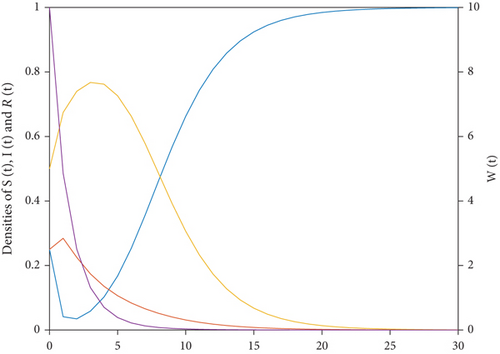
Let Λ = 1, k = 2, β = 0.9, λ = 0.5, m = −0.2, μ = 0.6, α = 0.2, and η = 0.8, and calculate R0 = 1.9792 > 1, m < 0, β = 0.9 > 0.8 = (α + μ) and kβ = 1.8 > −0.02 = λm(1 − α − μ). The parameter values satisfy the conditions proposed in the third part of Theorem 3. Figure 3 clearly demonstrates the local asymptotic stability of system (1) with respect to the equilibrium point E∗ under this set of parameter values.

Let Λ = 1, μ = 0.6, η = 0.8, λ = 0.2, and k = 3. When the values of different parameters α, β, m > 0 and m < 0 change, the densities change of S(t), I(t), R(t), and W(t) are shown in Figure 4.

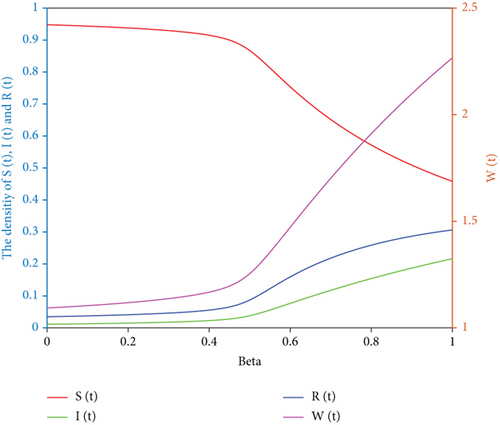
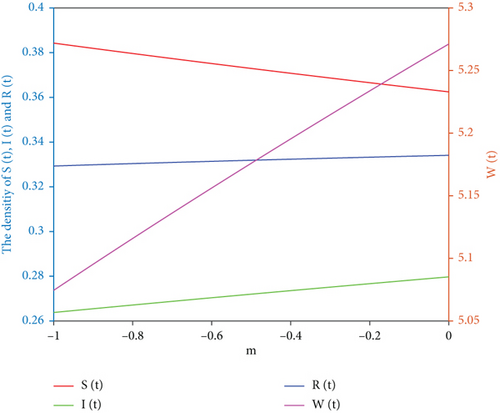
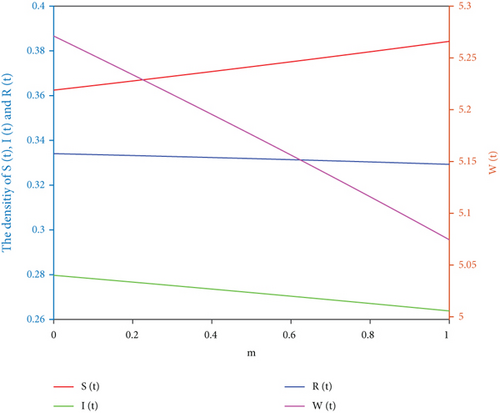
Figure 4 vividly indicates that when α increases, I(t) decreases and R(t) increases. When β increases, S(t) decreases, and I(t), R(t) and W(t) increases, which means increasing the probability of communicators turning into immune ones and reducing the probability of unknown people turning into communicators, which can effectively inhibit the spread of rumors. When m > 0, S(t) increases, and I(t) and W(t) decreases with time, while when m < 0, I(t) and W(t) increase, and S(t) decreases with time. It is not difficult to see from Figure 4 that positive publicity reports help to control the spread of rumors, while negative publicity reports are not conducive to controlling the spread of rumors. However, media reports cannot stop the spread of rumors.
5.2. Numerical Simulation of Optimization System
In this section, according to the method in reference [43], we use the fourth-order Runge Kutta algorithm to simulate the optimization system (45).
The values of simulation parameters in this section are Λ = 1, k = 0.2, λ = 0.9, m = 0.1, μ = 0.65, and η = 0.8, and the initial value is consistent with the previous text.
The weight coefficient in the objective function is difficult to determine, because it is related to the estimation of the cost of two different control strategies, and a large amount of data fitting is usually required to obtain a relatively appropriate trade-off coefficient.
Considering the selection of weight coefficient and the expression of optimal control μ1 and μ2, the final weight coefficients are c1 = 10 and c2 = 102. It is worth noting that it is difficult to reach the maximum value of control in reality. Therefore, the maximum value control strategy is not considered in numerical simulation.
Remark 1. Figure 5 is the corresponding S(t), I(t), R(t), and W(t) curves under different control strategies when c1 = 10 and c2 = 102, i.e.,
- (I)
Case without control: μ1 = μ2 = 0
- (II)
Single control case 1: μ1 = 0.5, μ2 = 0
- (III)
Single control case 2: μ1 = 0, μ2 = 0.5
- (IV)
Case of intermediate control: μ1 = μ2 = 0.5
- (V)
Case of optimal control:
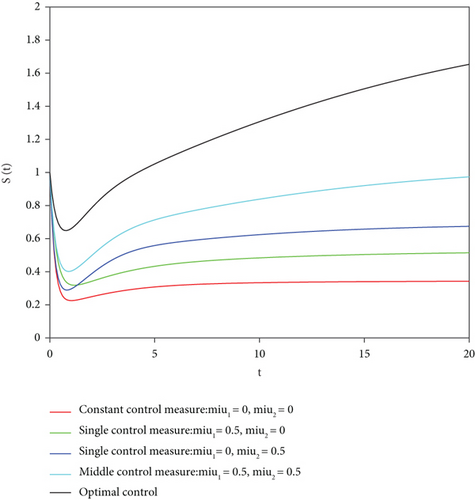
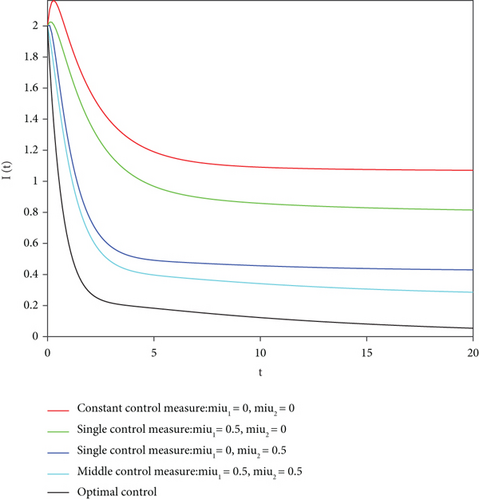
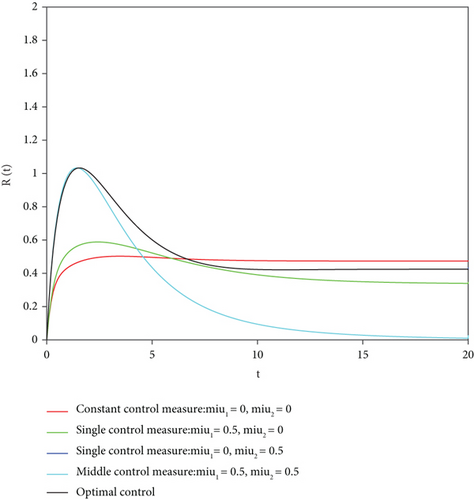
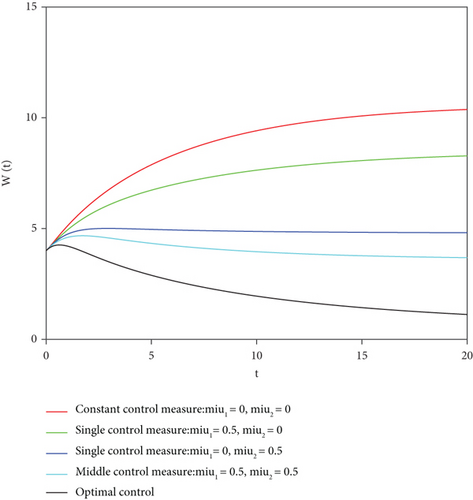
Figure 5 describes the quantity evolution curve of each bin under different control intensities when the weight coefficients c1 = 10 and c2 = 102 in the objective function. From the chart, we can see that in the process of reducing the number of communicators and immunizers, the effects of various control strategies should be as below: The optimal control effect is the best, followed by the intermediate value control effect. The effect of single control μ2 is not as good as that of intermediate value control, but it is obviously better than that of single control μ1, and single control μ1 is far better than no control.
6. Sensitivity Analysis of Threshold to Two Control Variables
This means that when other parameters remain unchanged, if the parameter β increases, the basic reproduction number R0 also increases. Therefore, the scale of rumor propagation increases. It can be seen from this that if ignorant individuals believe the rumors and spontaneously forward the rumors, it will promote the spread of rumors.
That means when other parameters remain unchanged, the basic regeneration number is R0 decreases with the increase of the parameter α, that is, the scale of rumor propagation decreases. It can be seen that if the disseminator loses interest in rumors or no longer disseminates rumor information for other reasons, it will reduce the spread of rumor information and help to control the spread scale of rumor information.
We plotted the three-dimensional relationship between R0 and the control variables μ1 and μ2.
In Figure 6, in order to intuitively see the effect of control parameters on the number of threshold R0, the three-dimensional curve of R0 and μ1 and μ2 is simulated with MATLAB. Figure 6 shows that the two control variables of R0 are monotonically decreasing, which means that preventive and punitive measures can better control the spread of rumors. The significance of the control strategy proposed in this paper is further confirmed.
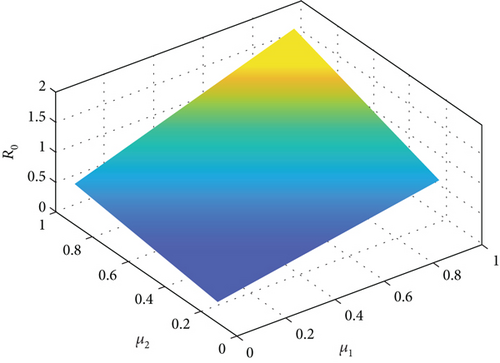
7. Conclusion
Based on the consideration of media reporting effect, this paper established a new rumor propagation model and explored the rumor propagation process under the new communication mode. Firstly, we regard the number of rumors in the media as a variable that changes over time and consider the impact of positive and negative media reports on the spread of rumors. Secondly, for the sake of abate the final cost of suppressing rumor diffusion, the optimal control problem of the model is proposed. Using Pontryagin’s maximum principle, the optimal control solution is calculated in the expected period. Finally, the images of the influence of different parameters on the process of rumor propagation are drawn through numerical simulation.
Compared with the existing literature, we also consider some control strategies, such as deleting rumor information and punishing rumor spreaders, and discuss the optimal control problem to control the scale of rumor propagation and reduce the cost. Numerical simulation shows that under the parameters given in this paper, the optimal control parameter values that meet the constraints can be calculated through quantitative analysis. This method provides a new idea for studying the optimal control of rumor propagation.
Through theoretical analysis and numerical simulation, it shows that the positive publicity and report of the media cannot prevent the spread of rumors, while the negative publicity and report of the media will affect people’s ability to correctly distinguish rumor information, so as to speed up the spread of rumors. In 2011, after the earthquake in Northeast Japan [44], there was a rumor that nuclear radiation would pollute the sea, and the quality of radiation salt led citizens to buy salt crazily. The sensational “doomsday theory” in 2012 led many people to buy all candles in supermarkets, causing unnecessary social panic [45]. Huo and Cheng [46] have described the impact of media coverage and emergency strategies by government on the transmission dynamics of information. That is, after the authorities released the information on eliminating rumors on the official media, the spread of rumors was greatly reduced. Therefore, our theoretical results are consistent with reality.
As a matter of fact, taking the openness and anonymity of the network into consideration, the role of rumor refuter also has an important impact on the process of rumor diffusion. Due to the limited energy, we do not explore the impact of the above factors on the spread process of rumors. It is our future research fields to explore the impact of these influencing factors on rumor propagation.
Conflicts of Interest
The authors declare that they have no known competing financial interests or personal relationships that could have appeared to influence the work reported in this paper.
Authors’ Contributions
Wenqi Pan contributed to the validation, writing-original draft, and writing-review and editing. Yuhan Hu contributed to the conceptualization and visualization. Weijun Yan contributed to the methodology. Ruimiao He contributed to the validation. Libing Wu contributed to the supervision.
Acknowledgments
This work was supported by the Humanities and Social Sciences Research Projects of Education Department of Liaoning Province China (No.2020LNJC11) and the Natural Science Foundation of Liaoning Science and Technology Agency of China (No.2022-MS-356).
Open Research
Data Availability
The data used to support the findings of this study are available from the corresponding author upon request.




